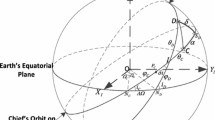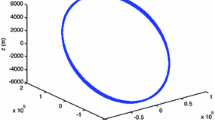Abstract
Satellite relative motion around the Earth has been thoroughly studied during the last two decades. However, considerably less attention has been given to the study of satellite relative motion around Mars. As the cost of space technologies decreases and more space missions are within reach, formation flying missions around Mars have the potential to benefit future exploration missions launched to the Red Planet. A key parameter in such missions will be the frequency at which the spacecraft need to perform formation-keeping maneuvers to compensate for unwanted drifts due to differential perturbations. The Martian \(J_3\) and \(J_4\) gravitational harmonics are significant enough to warrant a dedicated investigation of bounded satellite relative motion configurations. In this study, we derive conditions for bounded satellite relative motion in non-critical inclinations around Mars, while considering its gravitational harmonics up to \(J_4\). We first introduce a family of stable frozen orbits facilitating the implementation of formation flying and then apply differential nodal precession negation and differential periapsis rotation negation methods while considering the gravitational harmonics up to \(J_4\). Using this procedure, we demonstrate how the secular growth of the relative distance can be arrested during long time intervals.














Similar content being viewed by others
References
Alfriend, K.T., Vadali, S.R., Gurfil, P., How, J.P., Breger, L.S.: Spacecraft Formation Flying: Dynamics, Control and Navigation. Elsevier, Amsterdam (2010)
Aorpimai, M., Palmer, P.L.: Analysis of frozen conditions and optimal frozen orbit insertion. J. Guidance Control Dyn. 26(5), 786–793 (2003)
Broucke, R.A.: Numerical integration of periodic orbits in the main problem of artificial satellite theory. Celest. Mech. Dyn. Astron. 58(2), 99–123 (1994)
Brouwer, D.: Solution of the problem of artificial satellite theory. Astron. J. 64(1274), 378–396 (1959)
Carter, T.E., Humi, M.: Fuel-optimal rendezvous near a point in general Keplerian orbit. J. Guidance Control Dyn. 10(6), 567–573 (1987)
Clohessy, W., Wiltshire, R.: Terminal guidance system for satellite rendezvous. J. Guidance Control Dyn. 27(9), 653–658 (1960)
Coffey, S.L., Deprit, A., Miller, B.L.: The critical inclination in artificial satellite theory. Celest. Mech. Dyn. Astron. 39(4), 365–406 (1986)
Coffey, S.L., Deprit, A., Deprit, E.: Frozen orbits for satellites close to an Earth-like planet. Celest. Mech. Dyn. Astron. 59(1), 37–72 (1994)
Cutting, E., Born, G.H., Frautnick, J.C.: Orbit analysis for SEASAT-A. J Astronaut. Sci. 26(4), 315–342 (1978)
Gurfil, P., Kholshevnikov, K.V.: Manifolds and metrics in the relative spacecraft motion problem. J. Guidance Control Dyn. 29(4), 1004–1010 (2006)
Gurfil, P., Lara, M.: Motion near frozen orbits as a means for mitigating satellite relative drift. Celest. Mech. Dyn. Astron. 116(3), 213–227 (2013)
Inalhan, G., Hall, J.: Relative dynamics and control of spacecraft formations in eccentric orbits. J. Guidance Control Dyn. Conf., AIAA-2000-4443
Izzo, P., Rosengren, A.J., Dell’Elce, L., Gurfil, P.: Periodic corrections in secular milankovitch theory applied to passive debris removal. In: International Symposium on Space Flight Dynamics (2019)
Kholshevnikov, K.V., Vassiliev, N.N.: On the distance function between two Keplerian elliptic orbits. Celest. Mech. Dyn. Astron. 75(2), 75–83 (1999)
Lawden, D.F.: Optimal Trajectories for Space Navigation, pp. 77–89. Butterworths, London (1963)
Liu, X., Baoyin, H., Ma, X.: Five special types of orbits around Mars. J. Guidance Control Dyn. 33(4), 1294–1301 (2010)
Merson, R.H.: The motion of a satellite in an axi-symmetric gravitation field. Geophys. J. R. Astron. Soc. 17–52 (1961)
Nie, T., Gurfil, P.: Lunar frozen orbits revisited. Celest. Mech. Dyn. Astron. 130(10), 1–35 (2018)
Nie, T., Gurfil, P., Zhang, S.: Analytical conditions for bounded mean intersatellite distances in the \(J_2\) problem. J. Guidance Control Dyn. 41(10), 2144–2162 (2018)
Schaub, H., Alfriend, K.T.: \(J_2\) invariant relative orbits for formation flying. Celest. Mech. Dyn. Astron. 79(2), 1200–1209 (2001)
Schweighart, S.A., Sedwick, R.J.: High-fidelity linearized \(J_2\) model for satellite formation flight. J. Guidance Control Dyn. 25(6), 1073–1080 (2002)
Sedwick, R.J., Miller, D.W., Kong, E.M.C.: Mitigation of differential perturbations in formation flying satellite clusters. J. Astronaut. Sci. 47(3&4), 309–331 (1999)
Vallado, D.A.: Fundamentals of Astrodynamics and Applications. McGraw-Hill, New York (1997)
Xu, M., Wang, Y., Xu, S.: On the existence of \(J_2\) invariant relative orbits from the dynamical system point of view. Celest. Mech. Dyn. Astron. 112(4), 427–444 (2012)
Author information
Authors and Affiliations
Corresponding author
Ethics declarations
Conflict of interest
The authors declare that there is no conflict of interest associated with the work reported in this article.
Additional information
Publisher's Note
Springer Nature remains neutral with regard to jurisdictional claims in published maps and institutional affiliations.
Appendix
Appendix
Rights and permissions
About this article
Cite this article
Marcus, G., Gurfil, P. Bounded Martian satellite relative motion. Celest Mech Dyn Astr 133, 28 (2021). https://doi.org/10.1007/s10569-021-10025-9
Received:
Revised:
Accepted:
Published:
DOI: https://doi.org/10.1007/s10569-021-10025-9




